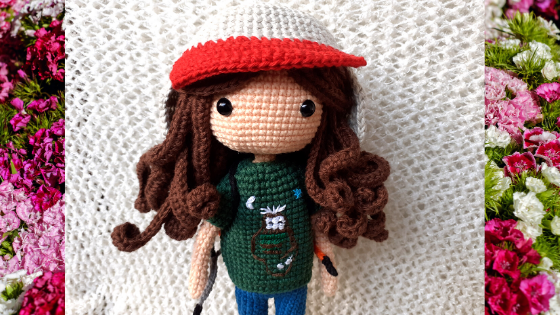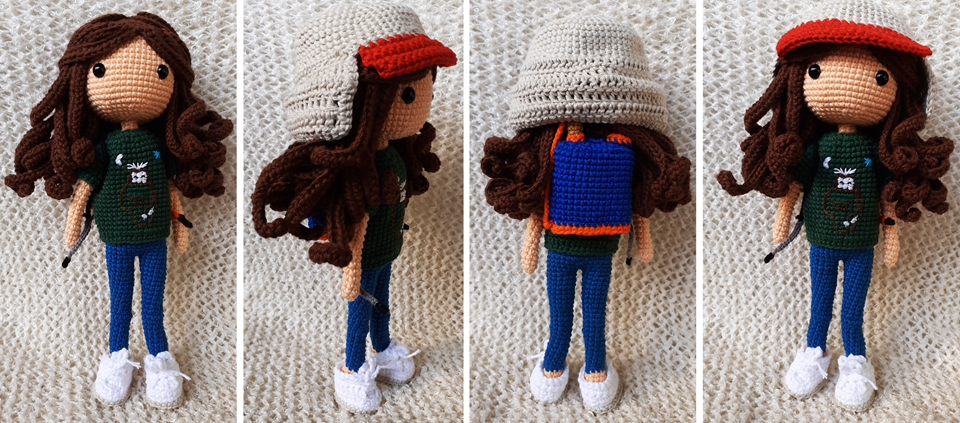Amigurumi #91: Personalizados VI
Agrónomos de corazón y formación
Hola, espero la estén pasando bien
Hi, I hope you're all right
Al momento de recibir un pedido, una de las cosas que pasa por mi mente son los colores, es decir si tengo a la mano dichos colores o similares; luego analizo las texturas y los detalles del personaje personalizado. Un dibujo general es importante, para darnos una idea del número de partes que contendrá y así sacar el tamaño. Aunque, a veces los clientes eligen el tamaño… aprendí a dejar pasar dichos pedidos, si bien los amigurumis vienen con un diseño propio, rediseñar toma tiempo extra.
When I receive an order, one of the things that crosses my mind are the colours, that is to say, if I have these colours or similar ones at hand; then I analyse the textures and details of the customised character. A general drawing is important, to give us an idea of the number of parts it will contain and thus get the size. Although, sometimes customers choose the size... I learned to let those orders go, although amigurumis come with a design of their own, redesigning takes extra time.

Volviendo al amigurumi, detallaré algunas partes importantes de este diseño:
El bordado de las figuras del polo, sí sigo hincándome los dedos. Para la mochila, por un momento no tenía idea de cómo empezar a tejerla, luego recordé las innumerables veces que la utilicé, por lo que no me costaría tanto plasmarla en un tejido 3D. Para quienes desconocen la mochila, este modelo es uno de los más conocidos en Perú. Se utiliza para aplicar de manera manual sustancias pesticidas y fertilizantes a las plantas. En un curso de la universidad nos enseñaron el uso correcto de esta mochila, ya en las prácticas pre profesionales aprendí a perderle el miedo y la utilizaba a diestra y siniestra. El cabello, este estilo de cabello fue similar al de la brujita lacia (Lita), es una técnica para evitar que sea tan condensado, seguiré practicando esta técnica hasta mejorarla. Pero de hecho, el cabello es donde más hilo consume.
Going back to the amigurumi, I will detail some important parts of this design:
The embroidery of the polo figures, I do keep sticking my fingers in. For the rucksack, for a moment I had no idea how to start knitting it, then I remembered the countless times I used it, so it wouldn't be so hard for me to shape it into a 3D fabric. For those who do not know the backpack, this model is one of the best known in Peru. It is used to manually apply pesticides and fertilizers to the plants. In a university course we were taught the correct use of this backpack, already in the pre-professional practices I learned to lose my fear and I used it left and right. The hair, this hairstyle was similar to the straight witch (Lita), it is a technique to avoid it to be so condensed, I will continue practicing this technique until I improve it. But in fact, the hair is where it consumes more thread.
A tejer:

The weaving was started by the feet, then a change of colour to steel blue. As it was woven, the galvanised wire was placed on each leg, this to achieve articulation and movement in the amigurumi (figure 1). The skin-coloured body was then woven and the arms were attached to the body. The polo shirt was woven according to the size of the body. The characteristic of the character is the embroidery inside the polo, these are a white moon (left), the celestial sun (right), the pachamama (in the centre) who by means of agricultural techniques such as terracing gives us food: potato, maca, sweet potato, corn, etc (figure 2). The head was woven in straight fabric, as they are safety eyes (number 8) these must be aligned (figure 3). The hair was woven with 40 chains in high half points. Below with magnification and at the top only half high points (figure 4).

The backpack has 2 hoses, one (orange hose) is directed to the hand lever and is for constant agitation to obtain a homogeneous mixture and the other (black hose) is for the substance to go directly to the nozzle and this to the plants (figures 5 and 6).

Usually the garments are woven with a greater number of crochets, this was the case with the slippers. The cap, is the classic used in the field, this model in addition to covering the face, covers the neck and ears.
¡Y eso es todo!,
¡…Hasta la próxima!
See you next time!
Dato curioso: Me encantó tejerla y también como quedó.
►Encuéntranos en:
- Facebook: https://www.facebook.com/iniciartecraft/
- Instagram: https://www.instagram.com/inici_arte_craft/
- Creary: https://creary.net/@diana.waranqa/
Omg😱...... Am so amazed
I'm glad you like it. Good vibes!
Absolutely beautiful.. And yes, redesigning on your own takes longer time but challenging. Something that you can be proud of after. ☺️
Of course, at the beginning I had no problems. Although there are people who ask you for specific measures, not knowing that every extra modification to the pattern (in the worst case) can make them deformed. Sometimes it's not just the fact of zooming in, it's a whole world of details behind it... That's according to my experience. Good vibes!